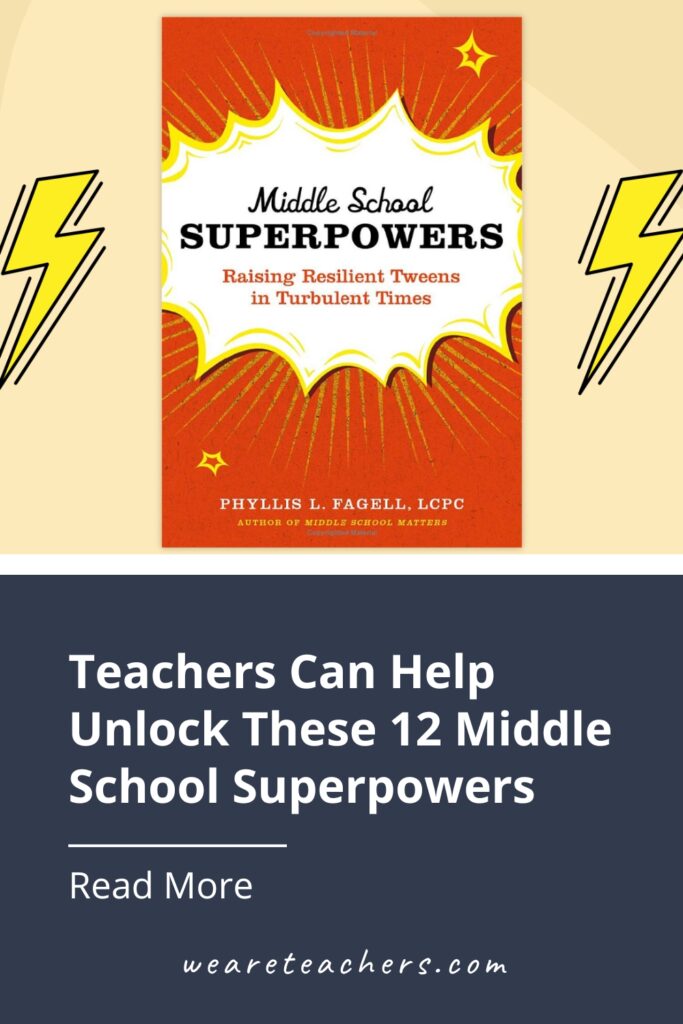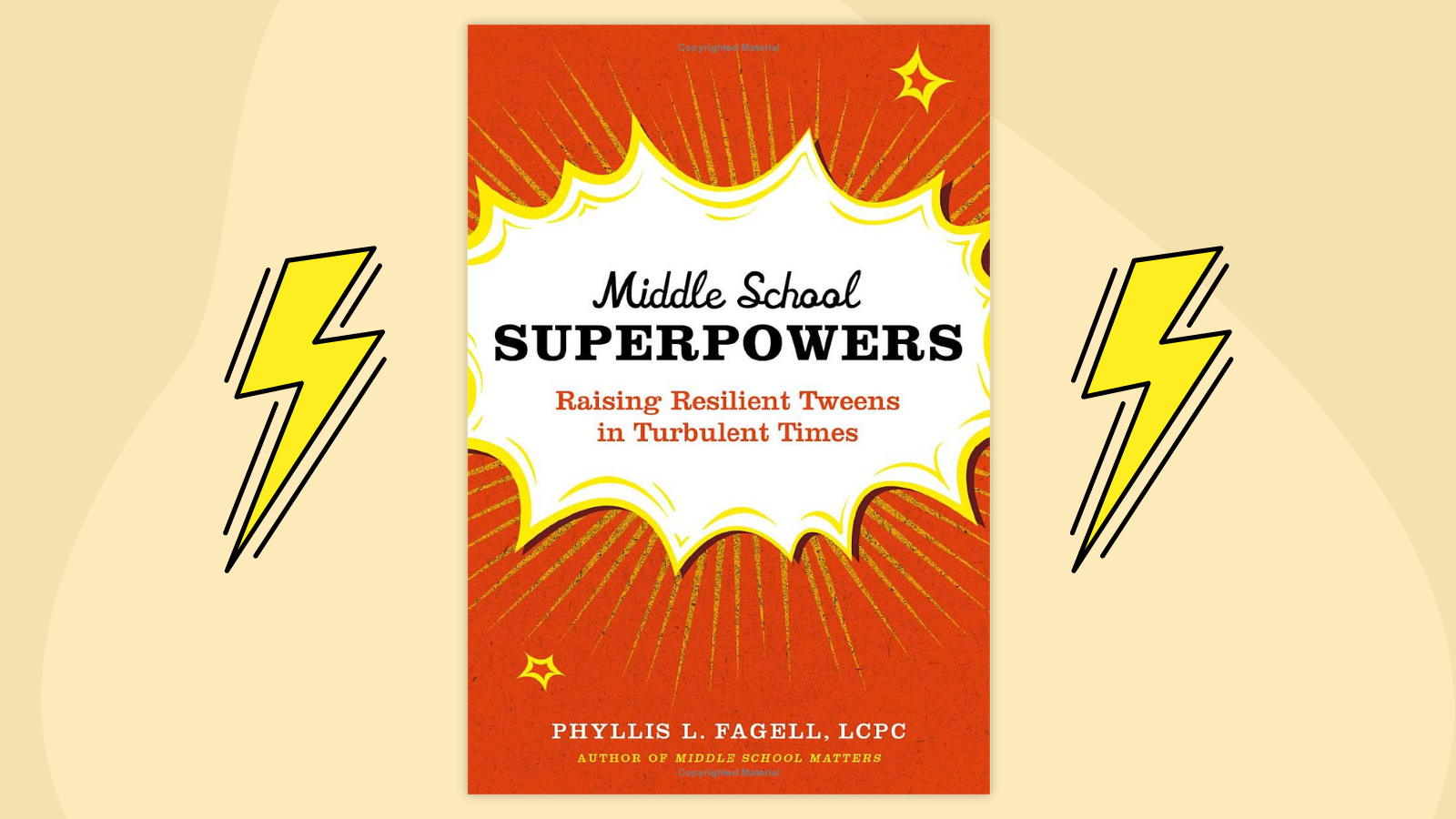To most adults, middle school behavior is an enigma. We’re often left scratching our heads at why one sideways glance from a peer or 70% on a math test can derail a student’s whole day. Parents and teachers might be tempted to conclude they’re being overdramatic.
School counselor and author Phyllis L. Fagell has a different explanation. In her latest book, Middle School Superpowers: Raising Resilient Tweens in Turbulent Times, Fagell offers insight into why middle school students seem so quick to fall apart and how parents and educators can equip them with the skills to face their challenges. (Spoiler alert: It doesn’t involve telling them to “get over it.”)
A rundown of Middle School Superpowers
Fagell identifies 12 “superpowers” that middle school students need to develop resilience. Examples include flexibility, vulnerability, and optimism. We all know these are important, but how can we instill them in our students? Fagell guides us through the process in each chapter. She opens each chapter by listing the occasions where the superpower in question is most relevant. Then, she includes real, often hilarious quotes from her own students demonstrating the need for the superpower. Next, she transitions into strategies to support its development. The final paragraphs of each chapter are suggestions tailored to educators. Finally, Fagell ends the chapter with a bulleted summary of strategies for initiating conversations with middle schoolers.
Throughout the book, Fagell excels by giving strategies to meet kids where they are. She equips educators with the language to validate student emotions, without absolving them of consequences. This is more than “feel good” fluff—it’s science-backed methods for instilling in students the skills they need to be successful.
Something that makes this book unique is how timely it is. Published in 2023, Fagell is able to reflect on the COVID-19 pandemic and its effect on student resiliency. The research she cites and advice she provides is influenced by her own students’ and children’s experiences following the pandemic. And while tried-and-true teaching strategies like building relationships or creating community are still necessary and relevant in the post-COVID era, the way we approach doing so must shift to meet students where they are. Fagell gets it, and she tailors her suggestions accordingly.
My two big takeaways for teachers
Though marketed as a parenting book, Fagell’s advice holds a lot of power for educators. I see this book becoming an indispensable teaching resource in two ways: first, as a guide for social-emotional learning and second for facilitating better one-on-one conversations with students.
1. Social-emotional learning
In my last school district, I taught a class called Study Skills every other day in a 90-minute block. There was no curriculum to follow, and any middle school teacher will tell you that expecting sixth and seventh graders to quietly occupy an hour and a half is a pipe dream. Knowing I’d need to provide more structure, I implemented a mini lesson at the start of each class period. The goal was to target a different academic or social-emotional skill every few weeks and provide students with easy, actionable steps they could take to develop it.
In retrospect, I wish I had this book while developing those mini lessons. Fagell provides so many quick and easy ideas for lessons that get students thinking about their emotions in a non-cheesy, middle school–approved way. My favorite comes from chapter 2, “Super Belonging.” In this activity, students watch a video clip of their choice without audio and identify the emotions they think the characters are feeling. Then, they watch the clip a second time with audio, and look for dialogue that supports their initial impressions. This one takes an investment of time, but others, such as identifying the core values a student most identifies with from a list, are significantly quicker.
If you’re having trouble justifying setting aside class time for SEL, consider this quote from chapter 8, “Super Security”: “When a middle schooler feels invisible, misunderstood, or devalued … that can prevent them from sharing their feelings or contributing to a class discussion.” By investing in social and emotional well-being, you’re setting up individuals and the community as a whole for academic success.
These don’t necessarily have to be just for class time. Fagell provides strategies that are easy to incorporate into other meeting times with students. Examples include my Study Skills class, an advisory, homeroom, or class meetings. For these ideas alone, the book is a worthwhile read.
2. Improving one-on-one conversations with students
Despite what our students might believe, teachers do not enjoy enforcing accountability (Or is that just me? I get zero joy from filling out discipline referrals. I’m guessing many of you reading agree.). Depending on the student and the emotions they bring to the conversation, discussing a violation of class norms can range from mildly uncomfortable to “spending all class dreading it”–level anxiety. I’m eager to approach these conversations from a new perspective this year by incorporating some of Fagell’s research-based strategies.
One suggestion that I intend to make a norm in my classroom comes from Katie Hurley. Hurley is a social worker and author whose work Fagell draws on throughout her book. My favorite Hurley quote comes in chapter 2, “Super Belonging.” She encourages the idea of students taking partial responsibility. “Own your two percent,” Hurley advises, “even if you believe it’s 98% the other kid’s fault.”
I love this idea, because it’s very rare that I’ll have a kid who says they’re not completely blameless. More often they’ll try to justify their choice because so-and-so did xyz first, etc. But if they own their 2%, it doesn’t matter what the other student did. It matters that they likely didn’t live up to their values (an important theme in the book!) and it’s up to them to own their actions. I can see conversations about hiding a classmate’s books or a lost homework assignment going very differently if students commit to owning their 2%.
Final thoughts
It may be listed as a parenting book, but Fagell’s latest work is an indispensable guide for educators. If you’re looking for methods to weave social-emotional learning into your classroom or need advice for approaching tricky conversations with students, this is the book for you!
Will you be picking up a copy of Middle School Superpowers? Let us know in the comments!
Plus, for more articles like this, be sure to subscribe to our newsletters.


